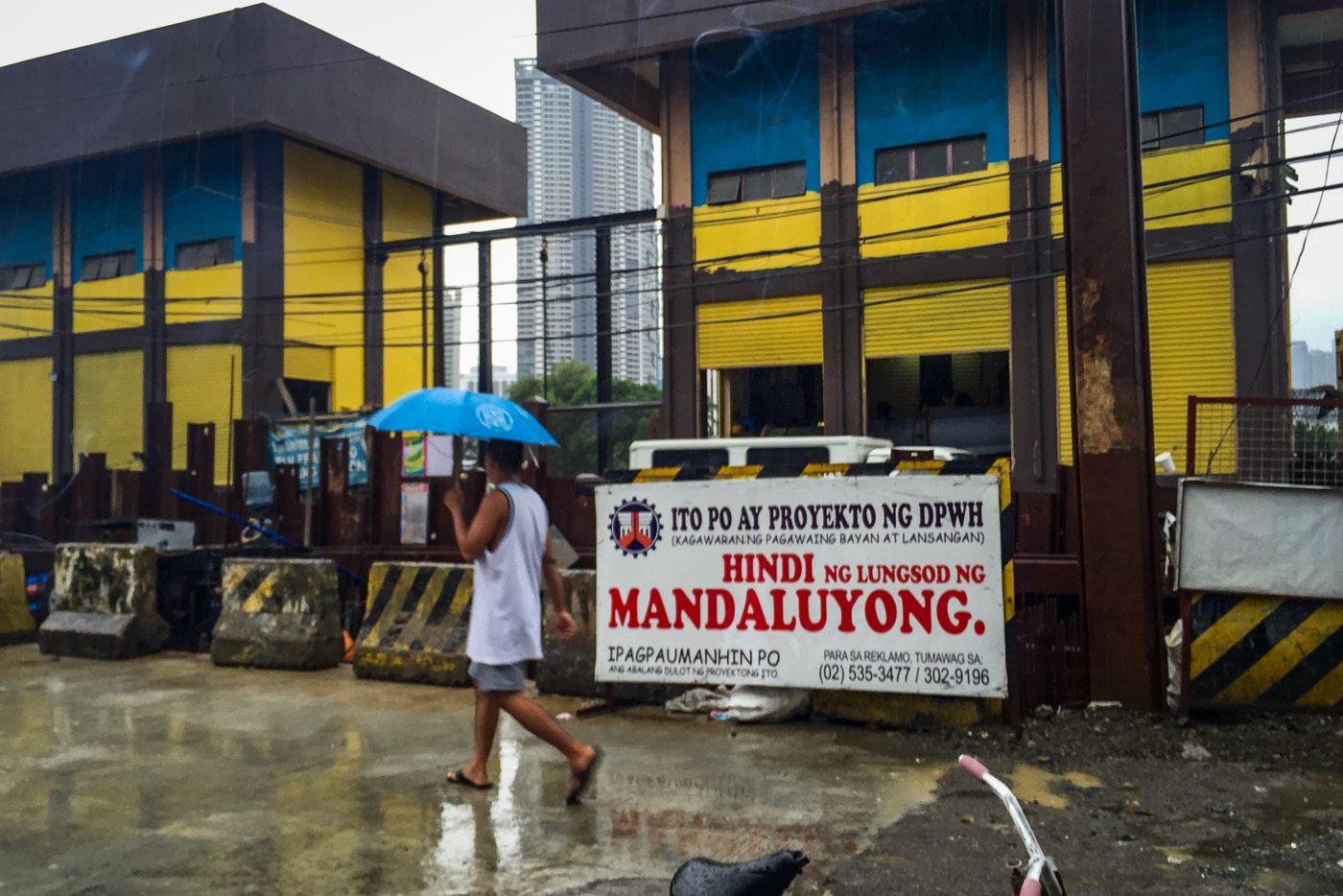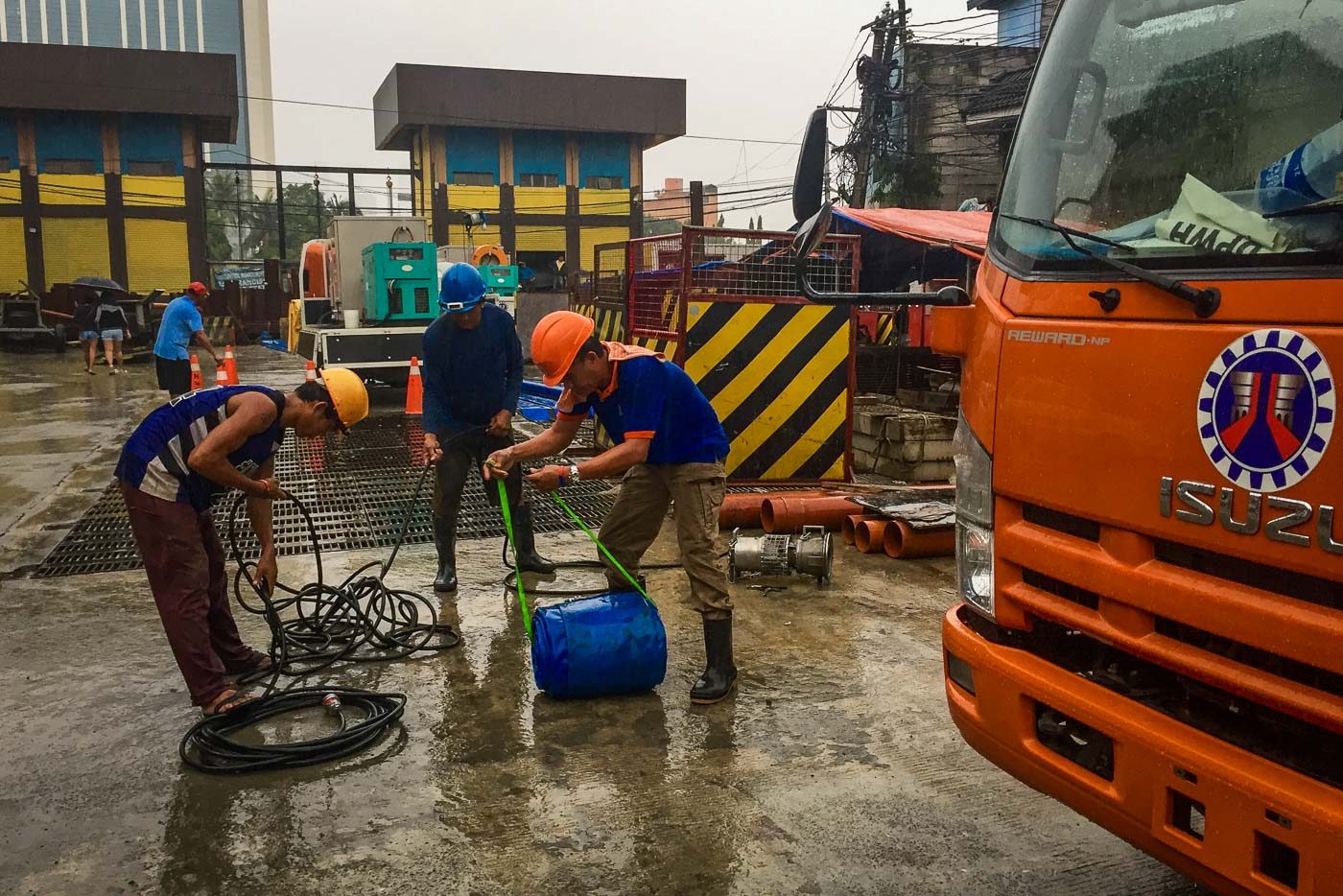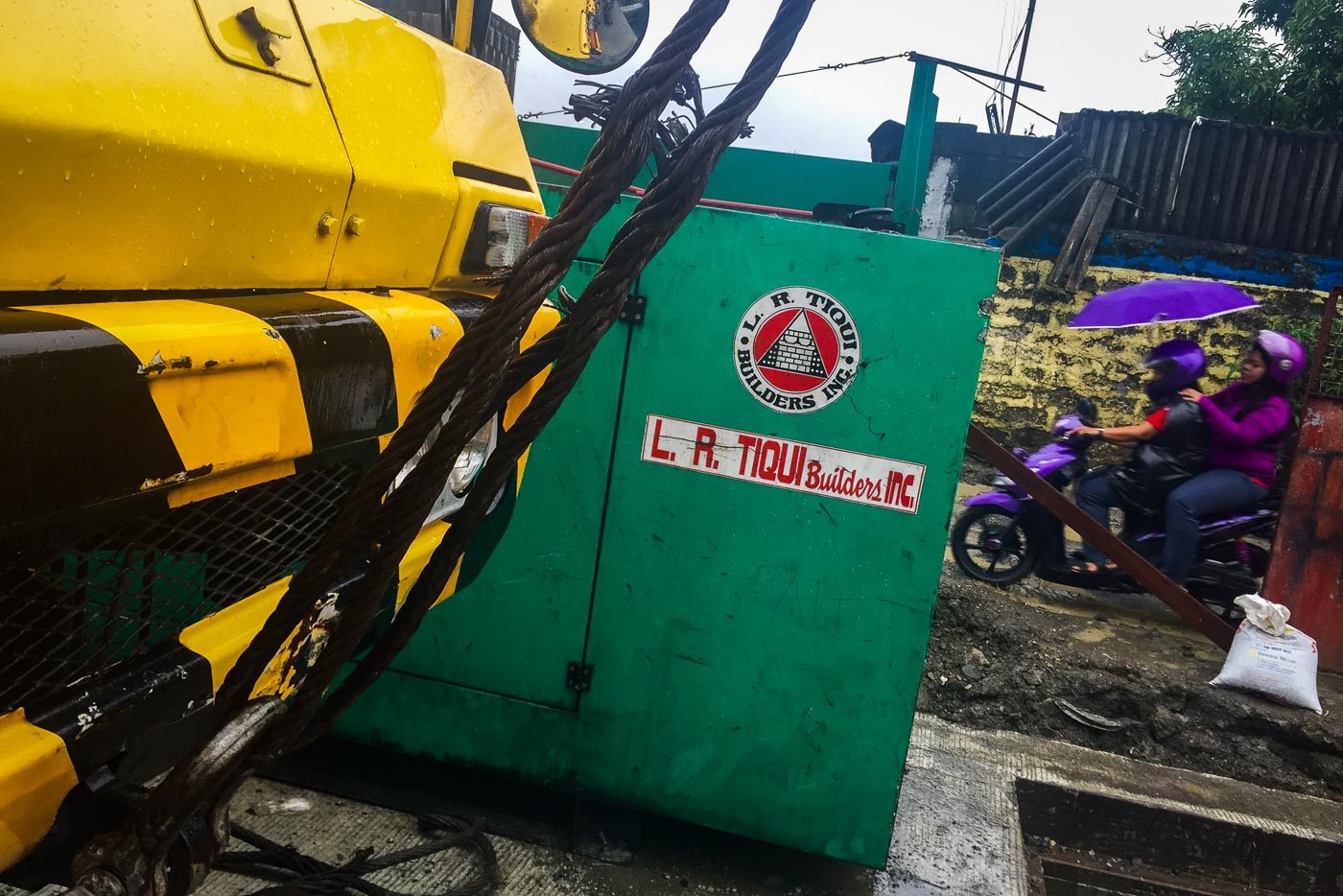SUMMARY
This is AI generated summarization, which may have errors. For context, always refer to the full article.

MANILA, Philippines – The perennially-flooded streets of Mandaluyong have become infamous: taxi drivers won’t pick up passengers who live in the area, refusing to wade through waters that can go waist-deep whenever torrential rains batter the metro.
The waters can take up to 3 hours to subside, trapping residents and leaving them with no other mode of transportation but a pedicab reinforced with a cardboard box. During the rainy season, pedicab drivers can make a killing: the usual P15 fare can go up to between P100 to P200 per trip.
In 2014, the national government began a P359.17-million project that was supposed to ease flooding, long a complaint of residents living near city hall and Maysilo Circle.
But ironically, it’s a flood control project that’s causing city residents great misery. For two years now, residents have had to put up with delays in the completion of the project.
This meant living with floods on rainy days and the dust from the project site on dry, sunny days; this meant arguing with cab drivers forced to make detours when roads are suddenly closed for construction. Several businesses have even shut down, as word of mouth about flooded streets spread around the city.
The problems associated with the flood control project have been a constant source of frustration for the local government, because residents direct their ire and complaints at them. City officials have had to put up signs telling the public that the agency responsible for the project is the Department of Public Works and Highways (DPWH) – and not them.
The project’s contractor has time and again missed its deadline for completion, despite promises and assurances given to the city government and the DPWH. But it now has its final ultimatum: finish the project by September 30, or – as the new DPWH secretary threatened – go swim in the floodwaters.
Work timetable
The Mandaluyong flood control project involves the construction of a reinforced concrete box culvert along San Francisco Street and the installation of a pumping system on the existing MMDA pumping station on Coronado Street.
Bidding for the project began in March 2014, with the contract approved 4 months later and awarded to L.R. Tiqui Builders Inc.
Work on the project began more than two years ago, on August 18, 2014, and was originally set to be completed on May 8, 2016. But a combination of factors – bad weather and problems at the work site – kept pushing back the completion date.
From its original May 2016 completion date, the contractor asked for extensions twice, moving the date to August 9 and then again to August 30, 2016. But the new DPWH Secretary, Mark Villar, gave the contractor an ultimatum: finish it by the end of September.
At the agency’s budget hearing at the Senate last September 13, Villar gave assurances the project is on track to being completed on time, and that they would “move heaven and earth” to get it done.
As of August 31, the project is now 92.06% complete, according to the DPWH website.

Suspended work
According to a timeline of events provided by DPWH flood control project director Patrick Gatan, the project had 4 suspension orders: 3 times due to bad weather, and one time due to an order by the Metropolitan Manila Development Authority (MMDA).
- December 15, 2014 to January 5, 2015: suspension order 1, after MMDA ordered the temporary suspension of excavation activities on metro roads
- July 4, 2015 to July 14, 2015: suspension order 2, due to unfavorable weather caused by Typhoon Egay
- August 21, 2015 to October 19, 2015: suspension order 3, due to unfavorable weather caused by Typhoon Ineng
- December 4, 2015 to January 3, 2016: suspension order 4, due to unfavorable weather caused by Typhoon Nona
The 4 suspension orders prompted the contractor to ask for an extension twice, moving the completion date to the second half of 2016. But aside from delays caused by rain and floodwaters that submerged the work site, there were still other factors that contributed to the delay.
“San Francisco Street was supposed to be closed off. The assumption was longer work hours, continuous, and traffic on San Francisco was going to be controlled so that the equipment could be moved freely. But we were not allowed continuous work because of complaints from the surrounding houses, so we had to stop at certain hours,” former DPWH secretary Rogelio Singson told Rappler.
They also faced the problem of sewer water flooding the worksite and affecting operations.
“We did not anticipate the huge volume of dirty water coming from a creek all the way from upper Mandaluyong, coming down to Maysilo, overflowing into the worksite…It’s not easy cleaning that up and it really affected the work,” he said.
The former DPWH chief added that he would often make unannounced Saturday visits to the worksite.
The DPWH even provided some of their own pumps to help get rid of the floodwaters.
These were some of the solutions the agency implemented to keep the project proceeding as planned. But one suggestion – to change contractors – was out of the question.
“Terminating would mean further delay…Rebidding alone will easily take 3 to 4 months. Rebidding or terminating would further delay the project,” Singson said.
Contractor to blame?
While the flood control project is under DPWH’s implementation, it’s the Mandaluyong city government that’s been getting much of the blame.
Public perception had gotten so bad that local officials even put up signs telling the public that it was a DPWH project.
For its part, the city government maintained that it did all it can to address the problem.
There have been multiple meetings and letters sent to DPWH and the contractor, city public information officer Jimmy Isidro said. But they cannot interfere with the project by rescinding the contract or even slapping sanctions on the contractor because it is a project of the national government.
Since Villar issued his ultimatum, Isidro said there have been some improvements. Construction was now 24 hours a day, he said, and floodwaters subside quickly during rainshowers.
Some projects of contractor L.R. Tiqui did not undergo public bidding. Project contracts amounting to over P900 million were signed by former president Gloria Arroyo 5 days before she stepped down in June 2010.
With expected completion date only a few days away, Isidro said the city government is now looking toward the future instead of finger-pointing.
But that future, he stressed, is one where L.R. Tiqui should no longer be a contractor for any project in the city.
“We already wrote [DPWH] a letter 5 months ago, stating our recommendation that this contractor right now be banned. ‘Wag na nilang kunin (Don’t hire them anymore),” he said.
He also suggested that local government units (LGUs) be given the performance bond from contractors undertaking projects of the national government, so that the local government can step in and use that money to complete projects left idle by contractors.
“Pag ‘di tumupad, kami tiwangwang. How can we bid a project na hindi naman namin dapat in the first place i-bid, dahil ‘di naman kami ang may proyekto, national? ‘Di kami puwedeng gumastos ng pera ng lokal,” he said.
(When the contractor doesn’t follow through, we’re the ones left abandoned. How can we bid a project that we could not have bidded out because it’s a national project? We cannot use the funds of the local government.)
The LGU, he added, only has the power to recommend or make suggestions for any nationally-funded project – but the final say remains with the DPWH.
“All we have to do is make pakiusap, minsan makaawa. ‘Di mo naman puwedeng ipatigil, ‘pag pinatigil mo kalaban mo naman national government, binibigyan ka na nga ng proyekto, tinatanggihan mo pa,” Isidro said.
(All we have to do is plead, sometimes beg. You cannot have it stopped, because when you do you’ll go up against the national government. They’re already giving you a project and you’re rejecting it.)
Midnight contracts
For the local government, much of the blame lies with the contractor.
L.R. Tiqui Builders, a construction company based in Bagbaguin, Sta Maria, Bulacan, has long been in business. According to records from the Securities and Exchange Commission, it was registered as a stock corporation in 1999, with 5 stockholders.
Under its accreditation with the Philippine Contractors Accreditation Board, it is licensed for general engineering and general building.
The company, however, has been linked to several controversies in previous years. A 2009 story of the Philippine Center for Investigative Journalism listed it as one of the top 10 contractors that clinched DPWH contracts despite being an “obscure firm.”
In 2010, 3 projects by L.R. Tiqui were tagged by the DPWH as among 19 questionable flood-control deals approved by then-president Gloria Macapagal-Arroyo.
Then DPWH secretary Singson said the projects did not undergo public bidding. He added that the contracts for the 19 projects, worth about P934 million in all, were signed on June 19 and the Special Allotment Release Order issued on June 25 – just 5 days before Arroyo was due to step down as president.
Two of the projects were based in Pampanga, while one was in Nueva Ecija:
- Arayat, Pampanga: P77,315,428.96
- Guagua and Lubao, Pampanga: P16,451,747.20
- Aliaga, Nueva Ecija: P18,292,974.84
The DPWH said it cancelled these questionable deals, but in October 2011 – after typhoons battered several provinces in Central Luzon, causing widespread flooding – the agency clarified that it only cancelled the contracts, not the projects themselves.
Singson added that the projects went through competitive bidding.
For the Mandaluyong drainage project, L.R. Tiqui still won the contract after it underwent the standard bidding process. But Singson said the problems that beset the construction process would have affected any contractor – whether it was L.R. Tiqui or any new contractor – if the project had been rebidded.
“There are reasons beyond any contractor’s control,” he said.
Asked about possible sanctions that can be slapped against L.R. Tiqui for the many delays, Singson said sanctions should be determined after the project is completed and the causes of the delay identified.
In this case, he said, there were factors that forced the contractor to stop operations.
“‘Pag umulan kasi talagang ‘di sila makakapagtrabaho. Hinuhukay, binabasag mo ang maliit na drainage para palitan ng bago. Kapag umulan ‘yan, hihinto ka ng trabaho dahil gagamitin mo ang luma. So talagang hindi kasalanan ng contractor ‘yun, dahil sa dami ng ulan na padadaanin sa work station,” he said.
(When it rains, they really cannot work. You’re digging up the current small drainage to replace with the new one. When it rains, you have to stop work because you’ll be using the old drainage. So it’s really not the contractor’s fault, because of the amount of rain flowing across the workstation.)

Expected benefits
While the constant flooding has affected businesses in the area, Isidro said the city prefers to take the long view. He pointed out that other big-name businesses have not left, anticipating the benefits of a completed project.
“We’re told that we’ve lost a lot in manhours and business profits. We take this as a loss, but we consider that once this project is completed, Mandaluyong will not have to suffer flooding anymore,” he said in Filipino.
The city can even put up a recycling plant and save on expenses by recycling floodwater. With a flood-free area and a 4- or 5-lane road, real estate prices may even go up – which would benefit city residents.
“Nalugi ka nga nang 3 taon, kikita ka naman ng habang panahon,” he said. (We may have incurred losses for 3 years, but we’ll be reaping the benefits for a long time.) – Rappler.com
Add a comment
How does this make you feel?





There are no comments yet. Add your comment to start the conversation.